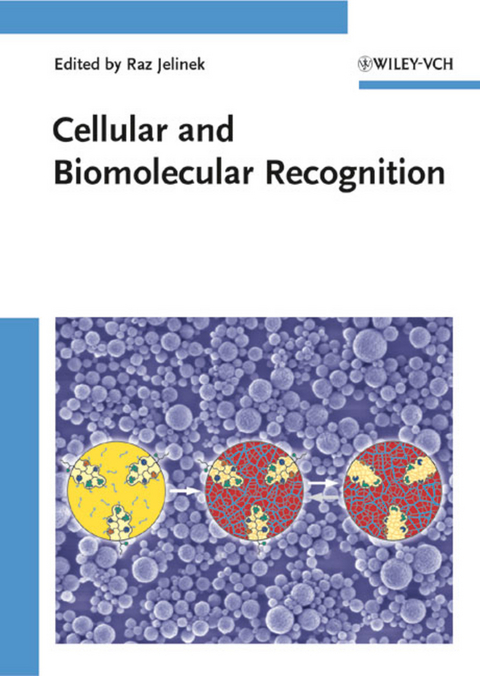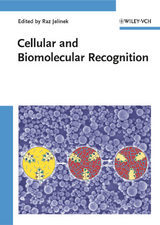Cellular and Biomolecular Recognition
Wiley-VCH (Verlag)
978-3-527-32265-7 (ISBN)
- Titel ist leider vergriffen;
keine Neuauflage - Artikel merken
Currently at the department of chemistry at Ben Gurion University, Israel, Raz Jelinek obtained his BSc in chemistry from the Hebrew University of Jerusalem, Israel, and his PhD from the University of California, Berkeley. He was a Cancer Research Institute post-doctoral fellow at the University of Pennsylvania, and is currently a Visiting Professor at the Department of Chemical and Biomolecular Engineering at Johns Hopkins University. Professor Jelinek has over 80 scientific publications and 10 patents to his name, and has received several scientific awards, including the Roger-Siegel-Brown Award of the Israeli Academy of Science and the Ruth L. Kirschstein National Research Service Award of the National Institutes of Health, USA.
DEVELOPMENT OF FUNCTIONAL MATERIALS FROM ROD-LIKE VIRUSES
Introduction
Overview
Programmable Protein Shells
Templated Syntheses of Composite Materials
Self-Assembly of Rod-Like Viruses
Virus-Based Device and Applications
Outlook
BIOMIMETIC NANOPARTICLES PROVIDING MOLECULARLY DEFINED BINDING SITES - PROTEIN-FEATURING STRUCTURES VERSUS MOLECULARLY IMPRINTED POLYMERS
Introduction
Core Materials and Functionalities
Functional Shells
Applications
Products
Conclusions
INTERACTION BETWEEN SILICA PARTICLES AND HUMAN EPITHELIAL CELLS: ATOMIC FORCE MICROSCOPY AND FLUORESCENCE STUDY
Interaction of Silica with Biological Cells: Background
Interaction of Silica Particle with the Cell Surface: How it is Seen with AFM
Ultra-Bright Fluorescent Silica Particles to be Used to Study Interaction with Cells
Ultra-Bright Fluorescent Silica Particles to Distinguish Between Cancer and Normal Cells
CHIRAL MOLECULAR IMPRINTING AS A TOOL FOR DRUG SENSING
Introduction
Electrochemical Drug Sensors
Optical Drug Sensors
Mass Drug Sensors
CATALYTIC ANTIBODIES FOR SELECTIVE CANCER CHEMOTHERAPY
Introduction
Catalytic Antibodies Designed for Prodrug Activation
Catalytic Antibody 38C2 and Cancer Therapy
Chemically Programmed Antibodies
NATURAL AND SYNTHETIC STIMULATORS OF THE IMMUNE RESPONSE
Introduction
Lipopolysaccharide Endotoxin - A Potent Immunostimulatory Molecule
LPS Recognition
Septic Shock
LPS Biosynthesis
Minimal Modified Lipid A
Isolation of "Natural" Kdo2-Lipid A
Synthetic LPS, Lipid A and Their Uses
Structural Studies
Bacterial LPS-Binding Proteins
Sphingolipids - Essential Membrane Components of Mammals, Plants, Fungi, Yeast and Bacteria
Natural Killer T Cells and GSLs
GSL Antigens
Structure - Activity Relationships
Saccharide Modification
Ceramide Modification
High-Resolution Structural Analysis of Receptor-GSL Complexes
SUPRAMOLECULAR ASSEMBLIES OF POLYDIACETYLENES FOR BIOMOLECULAR SENSING: COLORIMETRIC AND "TURN-ON" FLUORESCENCE APPROACHES
Introduction
Vesicular PDA Sensors for Colorimetric Signaling of Bacterial Pore-Forming Toxin
Fabrication of "Turn-On" Fluorescence Vesicle Sensors with PDAs
"Mix-and-Detect" Type of "Turn-On" Fluorescence Sensor for Bacterial Toxin
MULTIVALENT SYNTHETIC RECEPTORS FOR PROTEINS
Aminopyrazoles for Beta-Sheet Capping in Protein Misfolding Events
New Mechanisms of Enzyme Inhibition by Molecular Clips and Tweezers
Protein Surface Recognition by Tailor-Made Polymers
ANALYSIS OF BIOLOGICAL INTERACTIONS AND RECOGNITIONS BY SURFACE PLASMON RESONANCE
Introduction to Surface Plasmon Resonance Technology
Working Principle of SPR
Sensor Surface Chemistry and Its Fabrications
Important Factors Impacting on the Performance of SPR-Based Analyses of Biological Interactions on the Nonbiological Transducer Surface
Localized SPR of Inorganic Nanoparticles for Analyses of Biological Interaction
MEMBRANE-ACTIVE NATURAL AND SYNTHETIC PEPTIDES AND PEPTIDOMIMETICS
Introduction
Mode of Action of Membrane-Active Peptides
Natural Peptides
Synthetic Peptides
Peptidomimetics
LUMINESCENT QUANTUM DOT FLUORESCENCE RESONANCE ENERGY TRANSFER-BASED PROBES IN CELLULAR AND BIOLOGICAL ASSAYS
Introduction
Luminescent QDs
FRET
QD FRET-Based Protease Probes
NEW PROTEINS FOR NEW SENSING METHODOLOGIES: THE CASE OF THE PROTEIN-BINDING FAMILY
Introduction
Galactose/Glucose-Binding Protein from Escherichia Coli
Glutamine-Binding Protein from E. Coli
Trehalose/Maltose-Binding Protein from the Hyperthermophilic Archaeon Thermococcus Litoralis
Lipocalins and Odorant-Binding Protein
METHODS OF ANALYSIS FOR IMAGING AND DETECTING IONS AND MOLECULES
Fluorescent and Luminescent Proteins
Functional Peptides
Representative Technologies for Molecular Imaging
"The various contributors to this book provide novel experimental approaches and insights toward biomolecular recognition in biological systems." ( JACS Reviews , 2010)
| Erscheint lt. Verlag | 8.7.2009 |
|---|---|
| Sprache | englisch |
| Maße | 170 x 240 mm |
| Gewicht | 852 g |
| Themenwelt | Naturwissenschaften ► Biologie ► Biochemie |
| Naturwissenschaften ► Chemie ► Organische Chemie | |
| Schlagworte | Biomolecules (DNA, RNA, Peptides, etc.) • Biomoleküle (DNA, RNA, Peptide) • Biotechnologie i. d. Biowissenschaften • Biotechnology • Biowissenschaften • Chemie • Chemistry • DNS (Desoxyribonukleinsäure) • Life Sciences • Molekularbiologie • Organic Chemistry • Organische Chemie • Peptide |
| ISBN-10 | 3-527-32265-5 / 3527322655 |
| ISBN-13 | 978-3-527-32265-7 / 9783527322657 |
| Zustand | Neuware |
| Haben Sie eine Frage zum Produkt? |
aus dem Bereich




